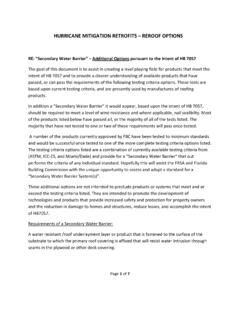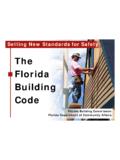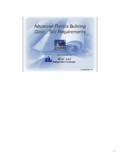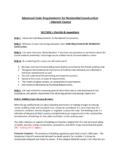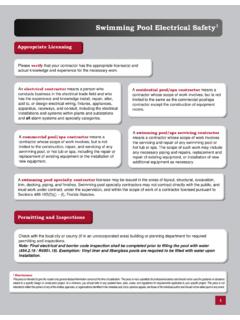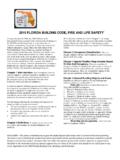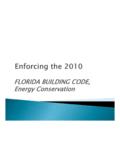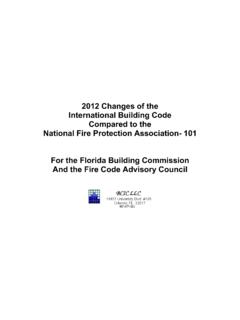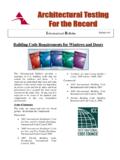Transcription of Window Systems1 - Florida Building
1 Florida DEPARTMENT OF1 DISCLAIMER This piece is intended to give the reader only general factual information current at the time of publication. This piece is not a substitute for professional advice and should not be used for guidance or decisions related to a specific design or construction project. This piece is not intended to reflect the opinion of any of the entities, agencies or organizations identified in the materials and, if any opinions appear, are those of the individual author and should not be relied upon in any event. Applicable to 2004 Florida Building Code. Community Affairs Window Systems1 Most people think of a Window s function as simply to allow light and air into the home.
2 But when you think about it, a Window in a Florida home has a rather complicated job: it must allow the sun s light to pass through, but not the sun s heat. It must keep cool conditioned air inside, but not allow condensation to form on the surface of the glass. It must not allow hot, humid outside air to leak into the home in summer, nor allow warm inside air to leak out of the house in winter. And as a result of Hurricane Andrew, it s now realized that windows are a key point of entry for wind, rain and wind-borne debris. The Florida Building Code (FBC) requires windows to be impact-resistant or protected if located within one mile of the coast where the wind speed is 110 mph or greater.
3 (Of course, even if your home is not located in this area, this may be a good idea.) As you can see, a Window is a complex system, and it s more than just glazing (glass): it also includes the frame sash and any operable elements as well. With the improvements in Window technologies, it is now possible to buy impact-resistant and/or energy-efficient windows for your home. The FBC prescribes performance and construction requirements for exterior windows and glass doors installed in wall systems. Testing by an approved testing laboratory is required, and approved labels must identify the manufacturer, performance characteristics and approved product certification agency, testing laboratory, evaluation entity or Miami-Dade notice of acceptance (NOA).
4 Note that the requirements vary depending on your location within the state. Testing There are testing standards set forth by the American Society for Testing & Materials (ASTM) and/or others that must be met before a Window is certified as being impact-resistant. One of the most stringent testing requirements is referenced in the High Velocity Hurricane Zone (HVHZ) section of the Florida Building Code, which applies to Miami-Dade and Broward Counties. Every exterior opening, residential or commercial, must be provided with protection by shutters or impact-resistant windows against wind-borne debris caused by hurricanes in the HVHZ. The Florida Product Approval System, under the Florida Building Commission, covers products that affect the structural integrity of buildings therefore windows are included.
5 A company may have its products approved for local or state use. Click on Product Approval at for more information. Note that not all areas of the state require impact-resistant windows . Check with your local Building official to determine if you live in such an area. However, if this is a concern, Miami-Dade County has the strictest test protocols in the country for wind-borne debris, air and water tests. The Florida Building Commission recognizes products receiving Miami-Dade NOAs as state-approved products. Tempered Glass windows Note that tempered glass windows and impact-resistant windows are not the same. Tempered glass is one type of heat-treated glass in which the glass is first heated, and then the surface is rapidly cooled.
6 This treatment results in the center of the glass remaining relatively hot compared to the surface. As the center thickness cools, it compresses the surfaces and edges. When tempered glass does break, it fractures into small, relatively harmless fragments. This phenomenon, often referred to as dicing, greatly reduces the likelihood of injury to people. The FBC requires safety glazing material, such as tempered glass, where there is a reasonable likelihood of exposure to human impact, as in door assemblies, bathtub or hot tub enclosures, railings or glass adjacent to stairways, etc. Safety glazing materials are designed to reduce or minimize the likelihood of cutting and piercing injuries when broken by human contact.
7 Impact-Resistant Glazing Impact-resistant glazing is available as laminated glass and is also considered a type of safety glazing. Laminated glass consists of two or more panes of clear glass bonded together with clear plastic-like film (usually polyvinyl butyral) sandwiched between the two. This inner filling ranging in thickness from .015 to .090 inches, which can be ordered in various colored tints to help reduce UV damage in the home, tends to hold the glass together upon impact. If cracked or broken, the glass fragments tend to adhere to the plastic interlayer thus preventing water, wind or wind-borne debris from entering the structure. Note that the frames for laminated glass are generally heavier than for regular residential windows , because although the glass may not break, a strong force could hit the Window hard enough to cause the entire frame to give way.
8 When undergoing testing, the Window is tested as a unit that includes the glass, frame, attachment hardware, and the installation method. Products designed to protect your home's openings must be both tested and approved for wind load and wind-borne debris. Keep in mind that all glass other than impact-resistant Window glass, even if tempered, reinforced or insulated needs to be protected during severe wind events. Proper Installation The proper attachment of the Window to the structure is critical to the performance of the Window . Each manufacturer specifies how its impact-resistant windows must be installed to offer the maximum amount of protection when confronted by storm-driven debris.
9 The FBC has certain requirements for Window installations but primarily refers to following the published manufacturer s recommendations. Detailed information about Window and door installation is provided in the American Society for Testing and Materials (ASTM) standard ASTM E 2112 (Standard Practice for Installation of Exterior windows , Doors and Skylights), a comprehensive installation guide. Look for an installer who has extensive experience and is familiar with this document or other installation specifications as available through the American Architectural Manufacturers Association (AAMA) and who follows the manufacturer s installation guidelines.
10 Insurance Benefits Visit the Florida Wind Insurance Incentives website to search for wind insurance incentives, such as impact-resistant glazing or shutter protection for windows , which reduce wind damage. Check with your homeowner s insurance carrier to see what kind of a discount is available. Benefits from impact-resistant windows extend beyond storms to broader security concerns such as reduced break-ins and theft. Note: Please be aware there is on-going discussion as to possible problems with occupant's and rescue personnel's inability to get through impact-resistant egress windows during an emergency. Energy Performance of windows The National Fenestration Rating Council (NFRC) offers a voluntary testing and certification program for thermal performance for windows and residential door products with glass.
